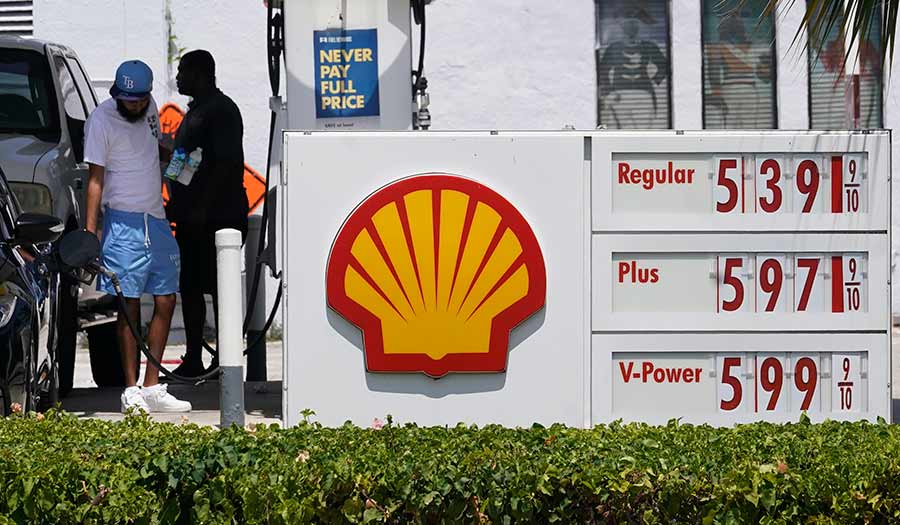 AP/Marta Lavandier
AP/Marta Lavandier
World News Desk
Learn the why behind the headlines.
Subscribe to the Real Truth for FREE news and analysis.
Subscribe NowWASHINGTON (AP) – U.S. inflation surged to a new four-decade high in June because of rising prices for gas, food and rent, squeezing household budgets and pressuring the Federal Reserve to raise interest rates aggressively—trends that raise the risk of a recession.
The government’s consumer price index soared 9.1 percent over the past year, the biggest yearly increase since 1981, with nearly half of the increase due to higher energy costs. With the cost of many goods and services rising faster than average incomes, a vast majority of Americans are feeling the pinch in their daily routines.
For 72-year-old Marcia Freeman, who is retired and lives off of a pension, there is no escape from rising expenses.
“Everything goes up, including cheaper items like store brands,” said Ms. Freeman, who visited a food bank near Atlanta this week to try and gain control of her grocery costs. Grocery prices have jumped 12 percent in the past year, the steepest climb since 1979.
Accelerating inflation is a vexing problem for the Federal Reserve, too. The Fed is already engaged in the fastest series of interest rate hikes in three decades, which it hopes will cool inflation by tamping down borrowing and spending by consumers and businesses.
The U.S. economy shrank in the first three months of the year, and many analysts believe the trend continued in the second quarter.
“The Fed’s rate hikes are doing what they are supposed to do, which is kill off demand,” said Megan Greene, global chief economist at the Kroll Institute. “The trick is if they kill off too much and we get a recession.”
The likelihood of larger rate hikes this year pushed stock indexes lower in afternoon trading. The central bank is expected to raise its key short-term rate later this month by a hefty three-quarters of a point, as it did last month.
After years of low prices, a swift rebound from the 2020 pandemic recession—combined with supply-chain snags—ignited inflation.
Consumers unleashed a wave of pent-up spending, spurred by vast federal aid, ultra-low borrowing costs and savings they had built up while hunkering down. As home-bound Americans spent heavily on furniture, appliances and exercise equipment, factories and shipping companies struggled to keep up and prices for goods soared. Russia’s war against Ukraine further magnified energy and food prices.
In recent months, as COVID fears have receded, consumer spending has gradually shifted away from goods and toward services. Yet rather than pulling down inflation by reducing goods prices, the cost of furniture, cars, and other items has kept rising, while restaurant costs, rents and other services are also getting more expensive.
The year-over-year leap in consumer prices last month followed an 8.6 percent annual jump in May. From May to June, prices rose 1.3 percent, following a 1 percent increase from April to May.
Some economists believe inflation might be reaching a short-term peak. Gas prices, for example, have fallen from the eye-watering $5 a gallon reached in mid-June to an average of $4.63 nationwide Wednesday—still far higher than a year ago.
Shipping costs and commodity prices have also begun to fall, and pay increases have slowed. Surveys show that Americans’ expectations for inflation over the long run have eased—a trend that often points to more moderate price increases over time.
Housing and rental costs are rising steadily as solid job gains encourage more Americans to move out on their own. Rents have risen 5.8 percent compared with a year ago, the most since 1986. And the cost of decorating homes is still increasing at a rapid pace—furniture prices are up 13 percent from a year ago—even as retailers such as Walmart and Target experience rising inventories, which should help lower prices.
The biggest shock has been energy prices, which soared 7.5 percent just from May to June. Gas prices have skyrocketed nearly 60 percent compared with a year ago.
- Real Truth Magazine Articles
- HEALTH ISSUES
 9 Ways to Eat Right When Money Is Tight
9 Ways to Eat Right When Money Is Tight
More on Related Topics:
- Its Economy and Infrastructure Battered, Can Lebanon Afford a War with Israel?
- 7 Money-saving Tips for the Grocery Store
- Scammers Are Swiping Billions from Americans Every Year. Worse, Most Crooks Are Getting Away With It
- Fight for Control of Yemen’s Banks Between Rebels, Government Threatens to Further Wreck Economy
- A Quarter of the World’s Children Under 5 Have Severe Food Poverty, UN Says


